As a many-time visitor to London, Mom ("Mum" in the UK) has long since abandoned the Tube in favor of walking and the occasional taxi. After spending four full days getting around London on foot, I tend to agree...although I still prefer the Tube over taxi for longer distances when I need to travel on a schedule.
I spent these four days amid intermittent bouts of steady rain and blustery winds climbing over 1000 steps at St. Paul's to the highest gallery you can go to, riding the London Eye at the south of the Thames, and meandering through alleys and back roads of London by following a couple of published walks I'd found in a book called
Secret London, as well as a guided tour that started in Covent Garden.

Doing St Paul's and the London Eye on the same day has a lot to recommend it--I got opposing views of the city, with the Eye like a silver ring standing on edge in the distance from the top of St. Paul's, and St. Paul's dome a tiny cap among square roofs from the top of the Eye.
St. Paul's lives up to its reputation for gilded beauty and art. Vaulted ceilings painted and tiled in saints and apostles and bible stories told in golds, deep reds, blues, and greens. Alas, no photos are allowed inside to protect the art and the reverence of the place--it is still a functioning church.
I did snap a few shots of the less-public innards as I climbed the wooden spiraling stairs to the Whispering Gallery inside the dome, and then wound my way up the second and third level of spirals (stone steps and metal staircase, respectively) to the exterior galleries for an overlook of the city. People used to be able to climb a ladder to the highest point of the church, but it's been closed for about 20 years according to one of the gallery attendants.
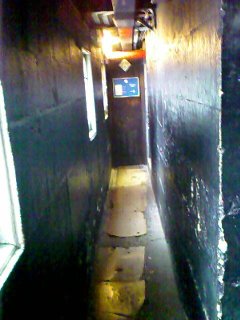

Outside on the galleries it was very windy--coats and hair and camera straps flapped around everyone. From the Golden Gallery, the section just above the cap of the dome, I took a photo down over the dome (below left) to the same spot from which I'd taken a photo of the dome from the ground (below right). The tall fir tree in the center of both images is the same.



I got a kick out of the simple graffiti on several walls of St Paul's interior corridors. Some that are carved into the stones date back to the 1700s and are only initials, while others, written and dated a month ago in pen, include Hotmail e-mail addresses. The desire to leave a mark that reminds others "I was here, please remember," seems universal across the ages.
I ate a sandwich lunch at the cathedral's Café in the Crypt (yes, the real crypt in the basement) among tombs and statues and memorials of people long dead. Tombstones had been stuck to the walls and laid on the floor as pavers. We tourists were shooed out from a small sideroom, the chapel in the crypt, at 1:30 so the room could be prepped for a wedding. A bit creepy if you ask me.
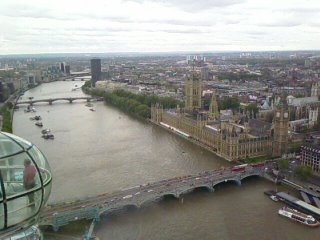
The London Eye was worth the walk from St Paul's (about 30 minutes), the price of admission (£9), and the bit of a wait (only 15 minutes this time of day). It's more like a people mover than a ferris wheel, taking 30 minutes to complete a circuit in the pods. I could barely tell we were moving, which was nice because it gives lots of chances for photos as we went round.
At the end of the circuit, the speaker system announces that a photo is about to be taken, Disneyland style, of everyone in the pod and instructs those who want to be in the photo to collect at a certain part of the pod, according to the NW, NE, SE etc. labels inside. The instructions were a bit confusing, and a large family gathered themselves together, faced the Thames, and grinned at what they thought was a camera inside the pod...just as I spotted the flash of the camera that was mounted behind us, on the Eye itself, taking a photo of what seemed to be an empty glass cabin.
I walked home that night from the Eye via Shaftsbury, Charing Cross, and Oxford St, coming upon two groups of Native American street musicians on side streets off of Oxford. They seemed like anachronisms in these London courtyards--dressed in leather-fringed, feather-headressed regalia and dancing to deerhide drums and wooden flutes and the hooyahiyaya rhythms that I usually hear in the Pacific Northwest. CDs for sale, of course.

The next morning, Sunday, Norman and Jean and I had planned to toodle around Islington, London. Rain delayed our start, so Norman taught me map and compass skills at their dining room table. They'll come in handy on the rest of the trip, especially in Dartmoor and Devon areaseas (if I get the and on the C2C walk.
We did troop off into town in the rain to take care of some shopping. I bought a pair of trekking poles in Tchibo's, and Jean and I each bought a new celery-green rain coat there. We looked like a pair of Kermit the Frogs.

After a lunch with Jean and Norman of smoked salmon, cheese, bread, and tea, the rain let up enough for Norman and me to head out toward Stoke Newington area.
The walk went through neighborhoods of Edwardian and Victorian era homes, some also late 1700s. All tidy and in rows. Some very posh areas per Norman. Elsewhere in town, Daniel Defoe, of Robinson Crusoe fame, had lived; we had a drink at the pub of his name.
The highlight of this walk for me was an out-of-the-way local cemetery--can't remember the name of it right now, Al-something. It was overgrown in a way that was both creepy and compelling.
Walkways ran through the area as if they were set for a forest stroll, but among the trees and tangles of knee-high shrubs stood hundreds of tombstones--many of them tilted and weathered and clustered and broken and moss-covered. An old stone chapel, once bright with stained glass windows and including a covered area that enabled mourners to dismount from their carriages out of the rain, was a decaying ruin.


My City walks on Monday started at St Paul's around 10:30a, with a pub lunch break at The Ship on the way. Today was a workday. Everyone in this area was dressed in black suits and black suit-skirts for the office. The famous beige-, red-and-black Burberry plaid was prominent in scarves, raincoats, and brollies (umbrellas). I was following a couple of walks in the
Secret London book, which offered numerous opportunities to duck into alleyways and corridors, some of them just wide enough for two people.

Alleys back home aren't generally considered safe or welcome places, and I had to pluck up the nerve to venture into them at first. However, alleys here are clear of debris and rubbish bins and the smell of urine, and are used regularly by everyone as shortcuts through town or by smokers chased out of their offices by non-smoking laws. Bummer in all this rain.
Truly off the beaten path, I never felt unsafe, although the couple of twisty dark corridors that lead to The Mitre, "London's most hard to find pub" (says
Secret London), felt like they were straight out of a Dickens novel, or perhaps the inspiration for Nocturn Alley in the HP books.
A warren of alleyways, curving side streets, and foot passages often led me to some very interesting pockets of shops, pubs, or public art. One street that housed the George and Vulture pub also had a high-end jeweler and a wall-mounted medallion marking the site of London's first coffee house in 1652 (no, not a Starbucks).
Through another, I came upon the house where Samuel Johnson, dictionary writer extraordinaire, lived for ten years while he wrote that famous 14,000-word tome. The house tour wasn't worth a £5 entry fee, but it was interesting in its way. It was four stories of mostly empty rooms and numerous engravings/portraits of Johnson's contemporaries on the wall. It did have a clever way of using hinged walls with doors to separate three rooms or make one great room.
I often trod on cobblestones or pavers and passed new or remodeling construction that had excavated through layers of brick and stone roads. Many former church gardens and cemeteries, with several of their erstwhile tombstones propped against walls, have become pocket parks where office workers come out for a cigarette or lunch.

I followed the trail to the ruins of a Roman crypt that the city planners had built around, in situ and surrounded by glass, as part of the bottom floor of an office building at Fleet street (former publishing mecca for newspapers).
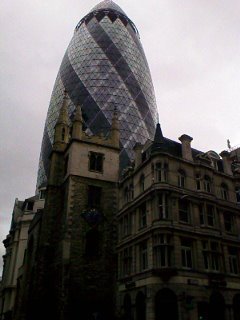
The contrast of old and new in London is extreme, especially in The City area. At first I found it too jolting to take; after a while, it grew on me enough to appreciate the efforts that Londoners are making to move ahead without also completely sacrificing the awareness of their ancient roots.
Having toured the city on my own, it was time for an official guided walk. The only one available to my schedule was "Behind Closed Doors" with Brian as guide. Starting at Covent Garden, we dropped in on the new Opera House, all glass and iron work and stone steps and shiny escalators.

Our next stop, twenty minutes at the Royal College of Surgeons was particularly engaging for the scientific or macabre minded (or, like mine, both).
This place contains the remaining part of an original collection by the Hunting (Hunter?) brothers, who spent their lifetimes as surgeons and medical, uh, explorers of the 1800s, collecting body parts and bones of people and animals and learning and lecturing from their findings. The upstairs of the college, recently opened to the public at no charge (but alas, like most museums, also closed to photos), is lined with glass displays explaining the often ghastly means and tools of medicine and surgery in those days, the development of anesthesia and antiseptics, and the stories behind some of the medical miracles, disasters, and oddities the men collected, such as the umber-colored skeleton of one Victorian fellow who stood over seven feet tall, and a tumor the size of a basketball that had been successfully excised from a man's neck.
A row of what looked like modern art paintings in red on dark backgrounds turned out to be human nervous systems laid out carefully onto boards for study. It was like a cross between a DaVinci study and a plate from Grays Anatomy.
The rest of the space was a biology lab on steroids. Medical students sat with sketchbooks in front of shelf after shelf of specimens marinated in formaldehyde or encased in resins. Biology samples included cross-sections of bones, muscles, rooster heads, tumors, bugs, and skulls. Up, down, and all around, room by room of them, stacked above the cases, and on glass shelves.

We also visited St. Clemens church, where many of the Royal Air Force and other military forces are honored. The floor is paved in stone and metal plaques commemorating many military feats in the UK and abroad. Brian especially pointed out the medallion for the squadron that helped break up German dams during WWII in order to stop the Germans from creating a nuclear bomb before the U.S. The story is covered in a great movie called
Dambusters--worth looking for at your local vid store or ordering from NetFlicks.
The last stop, the Royal Courts of Justice, was a highly secured site (metal detectors and bag searches), beautifully appointed in marble walls and arches, mosaic floors. It had a spot set aside for the history of judicial costume collection. I never realized how much the style of robes told about a person's job and stature in the legal system.
I hurried off to meet Kim, a friend of Leigh's, for lunch in the cafeteria of the Home Office, a centerpiece of UK government near Parliament. Entry was performed via a pass at the front desk, then a moment or two spent in one of the glass cylinder security pods that everyone uses each time they enter or exit the rest of the complex.

The cylinders are glass floor to ceiling and are barely big enough for one person to stand in. A card key opens one side, you step to a green circle on the floor, the glass door slides around to close behind you, you pause about 3 seconds in the pod, and a second door in front slides around to let you out. I felt a bit like one of the Surgeon's College specimens on display, or that I was about to be hit with a laser and beamed as particles to the other side of the planet.
The Home Office has colored glass panels along the roof line; the sunlight through them made an interesting Mondrian-like pattern on the sidewalk.
I made a failed attempt to record Big Ben's 3 p.m. bells--too much street noise to capture it well--and decided to skip a repeat visit to Westminster.

Instead, I walked from Westminster to Kensington via the south edge of St James Park, round Buckingham Palace along Constitution road, then through back-neighborhood roads and mews west of the Buck House. I came upon and meandered through Harrods a bit (the four floors of Egyptian-décor elevators are like something out of a Disneyland ride). Tired feet encouraged me to Tube back to the hotel.
Dinner was local--Abu Ali (Lebanese) restaurant off of Edgeware road. Mint tea (a Lipton teabag with a handful of fresh mint steeping in hot water); a salad chop of lettuce, tomato, peppers, cucumbers, and crunchy fried Lebanese bread as crouton in olive oil and pepper; and lamb chunks and more crunchy Lebanese bread swimming in yogurt and butter--a gyros in a soup bowl. Hot (temperature), tangy (yogurt), crunchy (bread), meaty (lamb), yummy, and filling.

I spent meal time naming my London photos, then went to an Internet cafe to upload them to my online folder and check e-mail. Lovely to use e-mail to stay in touch with folks, and to know I've got friends watching for word from me and sending good thoughts of safety and supply throughout my stay.
(P.S. Thanks to those of you who have left comments on my blog and/or have e-mailed to me. I love hearing from you all!)








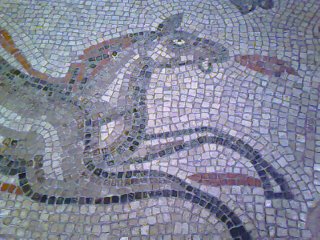











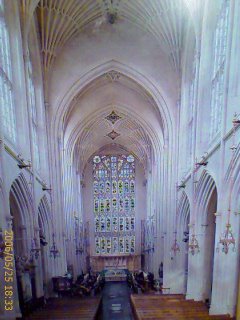

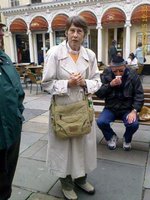




























 Instead, I walked from Westminster to Kensington via the south edge of St James Park, round Buckingham Palace along Constitution road, then through back-neighborhood roads and mews west of the Buck House. I came upon and meandered through Harrods a bit (the four floors of Egyptian-décor elevators are like something out of a Disneyland ride). Tired feet encouraged me to Tube back to the hotel.
Instead, I walked from Westminster to Kensington via the south edge of St James Park, round Buckingham Palace along Constitution road, then through back-neighborhood roads and mews west of the Buck House. I came upon and meandered through Harrods a bit (the four floors of Egyptian-décor elevators are like something out of a Disneyland ride). Tired feet encouraged me to Tube back to the hotel.